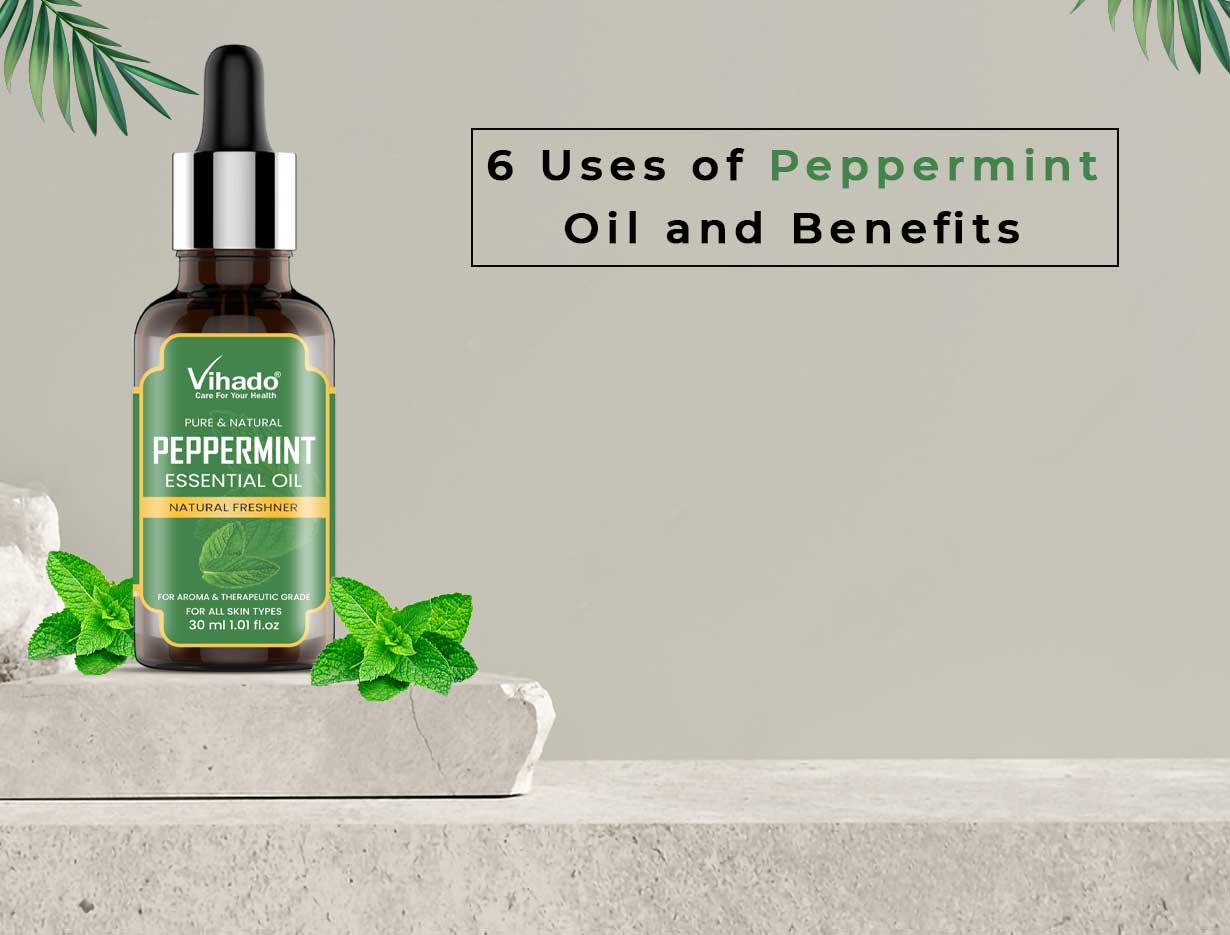6 Uses of Peppermint Oil and Benefits

What is Peppermint Essential Oil :
Peppermint essential oil has so many uses that it's no surprise that it's a mainstay in many people's medicine cabinets. And it does a lot more than just freshen your breath! It's used to treat nausea and other stomach problems, to wake up the senses before a long meeting, and to chill tired muscles (thanks to the menthol). Fortunately, peppermint also relieves congestion, headaches, and PMS symptoms.
It's worth noting that peppermint essential oil is significantly more potent and concentrated than other essential oils. The topical use of peppermint oil is typically harmless, although it must be diluted with a carrier oil, such as almond or jojoba oil. Some people, especially those with sensitive skin, may feel a burning sensation or an allergic reaction. More significantly, it should never be used on young children.
Menthol, an organic component with local anesthetic effects that delivers a delightful cooling feeling while naturally alleviating discomfort, is found throughout the plant. Antibacterial, antiviral, anti-inflammatory, insecticidal, antispasmodic, and carminative activities are also present.
6 Uses of Peppermint Oil and Benefits
Here are some uses and benefits of peppermint oil:
Indigestion
Peppermint is one of the oldest and most well-appreciated digestive herbs. Peppermint oil is beneficial to digestion since it has the carminative function of releasing gas (from the stomach or intestines so as to relieve flatulence or abdominal pain or distension).
How to use
1. To relieve motion sickness or general nausea, massage several drops into your tummy, lay a drop on your wrists, or inhale.
2. Mint tea has long been used to soothe an upset stomach.
3. Inhaling peppermint oil is also thought to suppress hunger by eliciting a feeling of fullness.
Colds/Congestion
Menthol can help with a variety of respiratory issues, including nasal congestion, sinusitis, asthma, bronchitis, and the typical cold and cough. It is frequently used in natural chest massages to aid with congestion.
To assist alleviate sinus and lung congestion, massage 2-3 drops (along with a carrier oil) over the chest or drop them into a humidifier.
If you have a stuffy head or can't stop coughing, try a peppermint essential oil steam. Fill a metal or glass bowl halfway with boiling water and a few drops of essential oil (eucalyptus and rosemary are good combinations with peppermint). Drape a towel over your head and raise your face 10-12 inches above the bowl to inhale the steam.
Headache
Peppermint oil is great to keep on hand at your workplace or in your handbag, especially if you suffer from headaches. This oil has also been shown to help reduce associated symptoms like nausea, vomiting, sensitivity to noise, and sensitivity to light.
How to use
To relieve headache and pressure, massage a tiny amount of almond or other carrier oil and a drop of peppermint oil on your temples, forehead, over the sinuses (avoid contact with eyes), and on the back of your neck. When used topically, peppermint oil has a relaxing, cooling effect that works wonderfully.
Stress
Because of its refreshing nature, peppermint, like many other essential oils, may give relief from stress, sadness, and mental tiredness. It also helps with feelings of anxiety and restlessness.
How to use
1. For stress reduction, a warm bath with essential oils of peppermint, lavender, and geranium helps alleviate stiffness while being absorbed through the skin.
2. Use a candlelight diffuser with essential oils to try aromatherapy.
Energy/Alertness
Peppermint oil has a profound effect on brain clarity and energy levels. If you're attempting to cut back on coffee, this may come in handy during your mid-afternoon slump.
How to use
1. To boost attention and alertness, rub a drop of oil under the nostril.
2. To boost focus and precision, diffuse peppermint oil throughout the room.
3. Apply to the back of the neck and shoulders many times during the day to maintain energy levels.
4. Inhale before and during exercise to improve your mood and lessen tiredness.
Sore Muscles
Peppermint oil contains analgesic, anti-inflammatory, and anti-spasmodic qualities, which means it can not only ease pain and inflammation but also calm the spasms that cause muscular cramps.
How to use
When used as a massage oil, Olba's oil (a blend of essential oils containing peppermint) has the extraordinary capacity to promote circulation at the skin's surface by opening pores and delivering a relaxing warm feeling to fatigued muscles and joints. This oil can also be used as a spot treatment for immediate results.
And the list of uses goes on...
1. To relieve itching from insect bites, use peppermint essential oil and lavender essential oil. It's comparable to the idea of using toothpaste or menthol cream, but without the mess. If you are sensitive to straight essential oil on your skin, dilute it with a carrier oil.
2. Add some peppermint oil to shampoo to treat dandruff.
3. If you have an ant problem in your home, place a peppermint-soaked cotton ball in their route. They don't like mint, and the pleasant perfume will stay in your home!
4. Add a few drops to a foot soak for treatment of painful, swollen, and overworked feet!
5. Refresh your garbage can area by adding a few drops to the bottom for a lovely minty scent.
Here you can check our Latest Blogs :
Uses of Cinnamon Essential Oil
Top 10 Uses for Clove Essential Oil
The Benefits of Lavender Essential Oil
Vitamin C Serum DIY for Men, Women & Kids
Uses and Benefits of Tea Tree oil in your Daily Beauty Routine
Follow our Instagram page for the latest updates: careforyourskin
https://bit.ly/3UwnvBe
Comments
Post a Comment